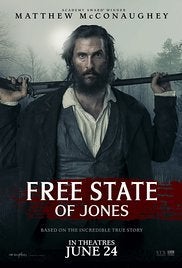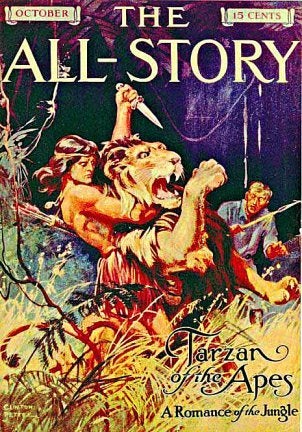I’ve got a fairly high bar for white antiracist activism, especially given my critiques. “God’s Angry Man,” John Brown, fills the bill.
That’s not to say that there are not many historical white figures who have made principled stands against racism, racial inequality, and both the banal and extreme forms of white supremacy evidenced in our social, political, and economic systems.
For example, it seems like Newton Knight, of the recent Free State of Jones fame, certainly qualifies in some respects. And I make this claim even as others have pointed out the ways in which he was very much complicit in slavery and the rather prickly question of interracial romantic unions of the time.

Yet, Hollywood’s depiction of characters like Newton often follows a rather trite formula. Their complexities and contradictions are flattened out so as to fill a stock mold—that of the “white savior.”
Some have suggested that The Free State of Jones is “doing something much more significant” with Newton Knight, such as exposing the ways in which “whiteness” was invented as a Faustian bargain for most European-descended Americans. “Whiteness” became a double-edged sword; as W. E. B. Du Bois put it:
It must be remembered that the white group of laborers, while they received a low wage, were compensated in part by a sort of public and psychological wage. They were given public deference and titles of courtesy because they were white. They were admitted freely with all classes of white people to public functions, public parks, and the best schools. The police were drawn from their ranks, and the courts, dependent upon their votes, treated them with such leniency as to encourage lawlessness. Their vote selected public officials, and while this had small effect upon the economic situation, it had great effect upon their personal treatment and the deference shown them. (Black Reconstruction, 1935: 700-701)
But this supposed cinematic exposé of the wages of whiteness is not in a zero sum relationship with the messianic media messages of the movie machine.
Hollywood is quite adept at recasting historical relations into nouveau racial dramas in which a white character can cross the color-line in solidarity with their darker brethren while simultaneously emerging as the sole mechanism for black agency and racial justice.
For instance, in Free State of Jones, both the runaway slaves and disaffected poor white folks, take their cues entirely from McConaughey’s savior character who, let’s just be honest, has “been there, done that” on the whole “white savior” role in both Amistad and A Time To Kill. Without the white savior as the moral-impetus-for-change incarnate, there is no black liberation. A “Free State” does not emerge from the social relations of interracial cooperation birthed in the collective imaginations of the oppressed, but from the singularly-minded obsession of a white paternal redeemer.
In this regard, I see little difference between The Free State of Jones and another racialized film of our contemporary moment: The Legend of Tarzan.

“Tarzan of the Apes” was originally written by Edgar Rice Burroughs, first published in The All-Story magazine in 1912. The character’s popularity skyrocketed and by 1918, the silent film Tarzan of the Apes graced movie palaces across the country. The admiration for “Tarzan” continued into the 1940s with over twenty sequels, particularly responsible for Burroughs making a short list of American authors to sell over 100 million books.

When we examine the genealogy of “Tarzan” we discover that in Burrough’s imagination, the name “Tarzan” is “ape-speak” for “white skin.” The whiteness of Tarzan—incorporated into the character's name—highlights the colonial and racial nature of the persona; Tarzan, heir to a British lord, becomes the white king of the African jungle.
Both Newton Knight’s depiction in Free State of Jones, and the nearly century old character of Tarzan are stories of white supremacy, patriarchy, and colonialism that rely upon three key assumptions.
First, these films employ a kind of noble savagery to connect both Knight and Tarzan to nature, spirituality, and a kind of primordial masculine strength that many worried was being lost in the urban industrial age of machines, science, and the takeover of a refined and “gentlemanly” etiquette. It re-asserts human, and specifically white male, domination over the earth, animals, nature, the elements—whether in the swamps of Mississippi or the jungles of “darkest Africa.”
Second, it necessitates that two kinds of characters orbit the gravitas of the White Savior. On the one hand are supremely racist white people as foils for the lead character, whether Confederates and Klansman for Knight or Belgium industrialists such as “Rom” (Christoph Waltz) in Tarzan. On the other hand, there are the folks of color, represented in Burroughs’ original language as "ignorant tribes of savage cannibals”, “of the lower orders”, and “fiendish … demons” that can be easily subdued with both intellectual cunning and brute force or as timid and tepid folks that either do not possess either the moral fiber or cognitive ability to revolt without a white guy at the helm, like in Free State of Jones. Both Tarzan and Knight labor to save Africa and African Americans from both the worst of whiteness and their own black dysfunction—from the tragedy of destruction by both greedy White industrialists in the Congo or greedy White planter classes in the South and a black indigenous or enslaved population of inept, ignorant, superstitious folks.
Third, these are stories that attempt to reconcile the crisis of white supremacy and imperalism, that fits just as much then as it does today. In 1918, when the first Tarzan film was made, England was a recent WWI victory, from which valuable military, financial, and material support were lent, which in turn had a bifurcating effect: England gained the most territory and subjects ever with land granted from the Treaty of Versailles, but the war effort also sowed some seeds of independence movements among English colonies, such as New Zealand and Australia. Moreover, in the US, immigration from Eastern Europe was reaching a peak (and was soon to be capped with the Immigration Act of 1924). With both European colonial empires and American resources seen as increasingly under attack or up-for-grabs from folks of color, many whites feared that their supposed racial and cultural supremacy was endangered. It was Tarzan who helped to reconcile and assuage those fears--there would always be a white king of Africa.
With Tarzan and Free State of Jones—who appears amidst a slate of televisual programming about race and slavery (from the WGN series "Underground" and the reboot of "Roots” to the just released trailer for Loving, about the Loving v. Virginia case of 1967), we are reminded that #NotAllWhitePeople supported slavery and racial terrorism. Moreover, amidst debate over both domestic social movements and geo-political tremors that are indelibly racialized: from "Black Lives Matter" and "Say Her Name" to the racist xenophobia underpinning Brexit and the "crisis" of what to do with Syrian refugees, white people can go to the movies and feel better about themselves.
Both films highlight white characters whose innate sense of justice drives a tale of racial cooperation, nonwhite uplift, and white redemption. In a climate in which many whites believe they are the true victims of the racial order, or who claim a kind of racial fatigue over listening to folks of color "complain" about racial inequality, and those who may even hold a latent desire to see evidence of a post-racial era, films that demonstrate a messianic white character reaching across the color-line certainly resonate.
These interracial depictions of friendly and cooperative race relations thus eschew any blatant dispatch of white supremacy. Rather, they rely on an implicit message of white paternalism and anti-black stereotypes of contented servitude, obedience, and acquiescence. Whiteness emerges as an iron fist in a velvet glove, the Knightly (pun-intended) savior of the dysfunctional “others” who are redeemable as long as they consent to assimilation and obedience to their white benefactors. In the end, both films help repair the most dangerous myth of race--a tale of normal and natural white paternalism.
